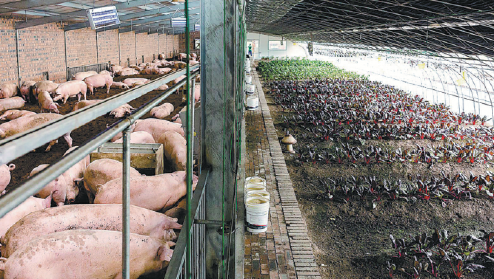Pig Palace: Where little goes to waste


Meaty issues
Within a few months of the launch, seven greenhouses were in service at the 40,000-square-meter base in Harbin, Heilongjiang province, each costing about 1 million yuan ($145,000).
The result: high-quality pork for consumers.
Under the bureau's model, pork costs no more to produce but the meat is of higher quality. Consumers are willing to pay double the normal price to get meat untainted by antibiotics or traces of other shadowy substances that can be detected by the tongue.
According to Wang Tianzhong, director of the operation, meat from happy pigs is infused with no strange smells. When it's cooked it's unusually tender.
It's also rich in nutrients, such as linolenic acid, an essential substance the human body must get from outside sources. The unsaturated fatty acid helps prevent obesity and diabetes, improves the skin and reduces cancer risk, Wang said.
"Our meat is rich in vitamin E, which is hardly found in traditionally raised pork," he said.
At the same time, the downsides of pork production diminish.
The circular-system farm is a promising economic breakthrough industry for the State-owned forestry bureau, which stopped all commercial logging in 2014.
In the largest greenhouse, about 300 pigs are raised in a partitioned room - half for the pigs and half for growing vegetables.
The floor is covered with a thick, brown, powdery mixture of crop straw, rice husks and sawdust 1.2 meters thick. It acts as a natural fermentation bed, adding beneficial bacteria that helps break down pig excrement's ammonia and hydrogen sulfide. It is replaced every two years.
In the other half of the greenhouse, various vegetables are planted in black soil, releasing oxygen and providing clean, fresh air for the pigs.
"Raising pigs in this way cuts waste down to zero and requires less human effort," Wang said. "The two friendly neighbors, pigs and plants, help each other. The carbon dioxide exhaled by pigs enhances photosynthesis for the vegetables."
To drive the waste fermentation process, certain bacteria are needed, and a lot of heat can be produced, similar to that of a garden compost pile. Additional warmth is generated by the pigs themselves. Heat is held in by the greenhouse membrane, and the house can reach 20 C naturally, even during Harbin's bitingly cold winters, when outside temperatures can plummet to-30 C.
"To ensure the quality of the beneficial bacteria, we usually collect strains near the pig farm," said Han Guosheng, a researcher from an ecological agriculture technology company in Beijing that tailored the technology for China in 2011, based on earlier advancements in Japan.
The facility must be on guard against fire, Wang acknowledged, given the flammable materials used in the fermentation bed and the facility's proximity to the forest.
- Death toll rises to 146 in Hong Kong residential building fire: authorities
- China recording rapid increase in flu cases
- New gas pipeline to benefit southern Xinjiang
- China holds first national civil service exam since raising eligibility age cap
- Chongqing launches fixed-schedule freight train service to Budapest
- HKSAR govt pledges free housing for Tai Po fire victims until homes rebuilt




































